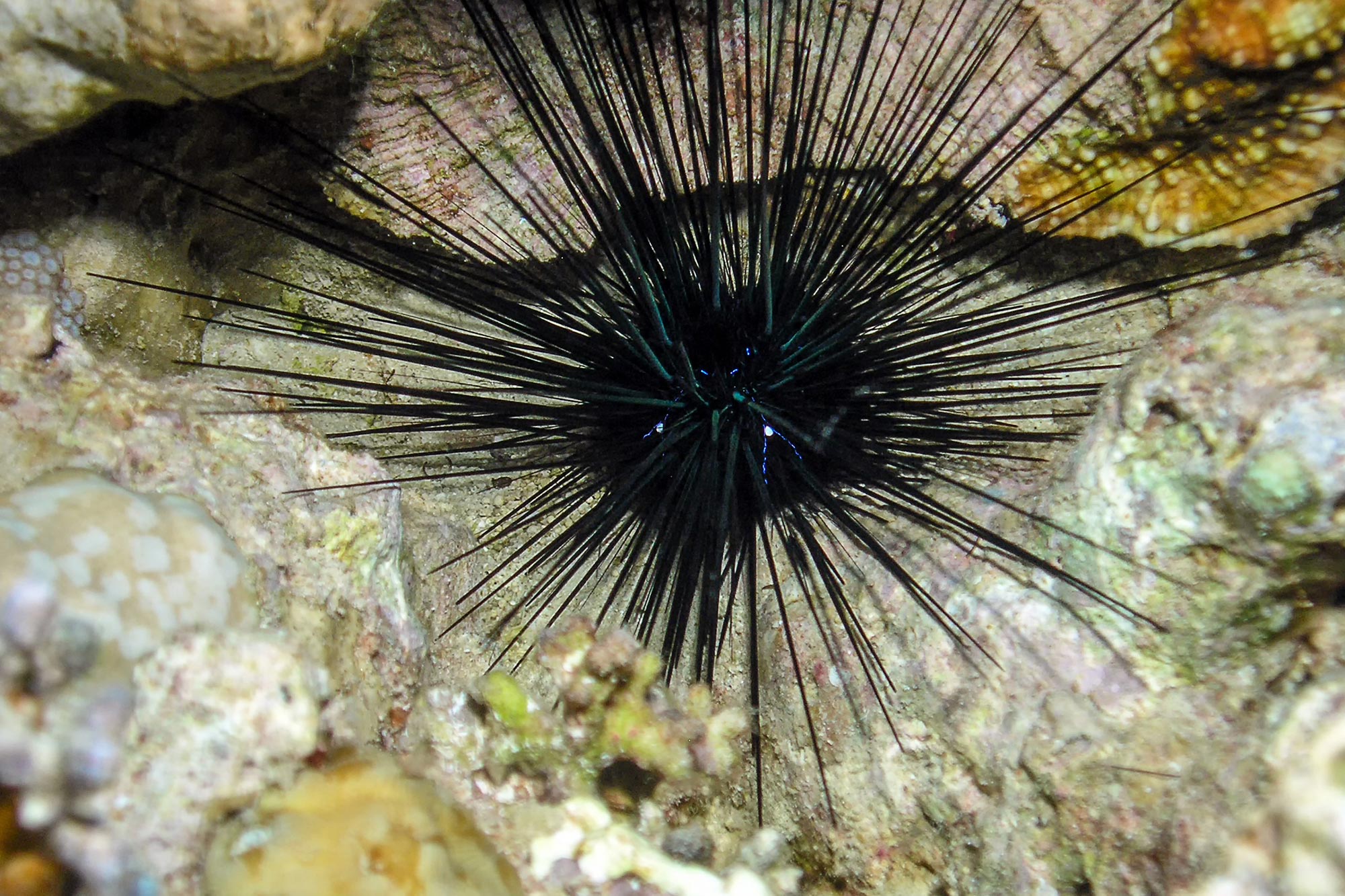
Organizm jednokomórkowy, scuticociliate, został zidentyfikowany jako przyczyna masowej śmierci jeżowców morskich na Karaibach i wschodnim wybrzeżu Florydy w 2022 roku. Te jeżowce są niezbędne dla zdrowia raf koralowych, a odkrycie rodzi pytania dotyczące obecności orzęsków, warunków ich wzrostu i potencjalnego wpływu na inne gatunki. Zdjęcie długiego, kolczastego jeżowca (Diadema antillarum).
Masowa śmierć jeżowca o długich kolcach – strata, która zagraża zdrowiu raf koralowych od Karaibów po wschodnie wybrzeże Florydy – została spowodowana przez jednokomórkowy organizm zwany orzęskiem.
Polowanie na zabójcę zakończyło się w 2022 roku, który zniszczył jeżowce o długich kolcach na Karaibach i wzdłuż wschodniego wybrzeża Florydy. Zespół naukowców zorganizowany przez Mię Breitbart, wybitną profesor uniwersytecką w College of Marine Sciences University of South Florida, zidentyfikował jednokomórkowy organizm zwany rzęską jako przyczynę masowej śmierci zwierzęcia morskiego, które jest niezbędne dla zdrowia rafy koralowej.
Ich odkrycia zostały opublikowane 19 kwietnia w czasopiśmie Nature
Ciliate culture viewed under the microscope. Credit: Mya Breitbart USF College of Marine Science
“We’re beyond thrilled to get to the bottom of the 2022 mystery and a bit stunned we did it so quickly,” said Breitbart, senior author on the Science Advances study and an expert in marine genomics. “We had a great team in place and the tools needed to do the ocean science equivalent of a forensic investigation.”
Ciliates are microscopic organisms covered in hair-like structures called cilia that help them move and eat. They are found almost anywhere there is water and most are not disease-causing agents. However, this specific species of ciliate – called a scuticociliate – has been implicated in die-offs of other marine species, such as sharks, in the past.

Photo compilation showing the same sea urchin before and after infection with the ciliate in the USF aquarium research facility. Credit: Makenzie Kerr USF College of Marine Science
Examining urchins collected from 23 sites in the Caribbean, the research team used a series of techniques to confirm the source of the die-off event.
After identifying the ciliate in every affected urchin specimen using genomic techniques, the team grew ciliates in the lab and performed infection experiments at the USF College of Marine Science. When the pathogen was introduced to otherwise healthy urchins in an aquarium tank, the urchins died within a few days – replicating what was taking place in the ocean and confirming the ciliate as the disease source.

DaSc-affected sea urchin, Aruba, August 2022. Credit: Ian Hewson Cornell University
“We’re excited to share this information with everyone, from reef managers to additional scientists so we can explore it further and try to stop its spread,” Breitbart said.

Mya Breitbart (USF) viewing the ciliate culture by microscopy. Credit: Makenzie Kerr USF College of Marine Science
The long-spined sea urchins inhabit shallow tropical waters and feed on algae that would otherwise destroy a reef. They began to lose their spines within days of contracting an unknown disease and died in droves starting in January 2022.
A similar die-off event took place in the early 1980s, which wiped out 98 percent of the long-spined sea urchin population. The culprit of that die-off remains a mystery.
Breitbart first got the call about the unfolding die-off at the end of March 2022. She immediately assembled a team consisting of Ian Hewson, lead author on the publication and a marine ecologist at Cornell University; Christina Kellogg, a microbiologist from the U.S. Geological Survey in St. Petersburg, Fla. who has worked extensively on coral reef diseases; and USF graduate student Isabella Ritchie.
“At the time, we didn’t know if this die-off was caused by pollution, stress, something else – we just didn’t know,” said Hewson, an expert in diseases that cause mass die-offs of sea stars, who flew from New York to the Caribbean Islands to observe the situation.
Even with the source of the mysterious die-off uncovered, questions still remain. For example:
- Is this ciliate new to the area, or was it there prior to the die-off?
- If it has been there, what environmental conditions favored its growth and why did it infect the urchins?
- Can it affect other species of urchins?
„Jedną z naszych teorii jest to, że orzęski dobrze rosły w warunkach wysokiej produktywności obserwowanych na Karaibach, kiedy po raz pierwszy zaczęły zanikać” – powiedział Kellogg. „Jesteśmy również ciekawi faktu, że niektóre obszary geograficzne, w których doszło do tego wyginięcia, i gdzie rafy koralowe zanikają z powodu choroby utraty tkanki koralowców, częściowo się pokrywają”.
Odniesienie: „Czynnik skutekocylanowy powoduje masową śmiertelność Diadema Antillarum na Morzu Karaibskim” Ian Hewson, Isabella T Ritchie, James S Evans, Ashley Alterra, Donald Berenger, Irene Bowman, Marilyn Brandt, Kayla A. Budda i Rolio A. Camacho, Thomas O. Cornwell, Peter D. Kimani A. Kitson-Walters, Patricia Kramer, Judith C. Lang, Harilaos Lessios, Lauren Liddy, David Marancik, Stephen Nimrod, Joshua T. Patterson, Marit Pistor, Isabel C. Romero, Rita Sellares-Blasco, Moriah LB Sevier, William Sharp, Matthew Souza, Andrina Valdez-Trinidad, Maren van der Laan, Brian Villanova-Cuevas, Maria Villalpando, Sarah de Von Huene, Matthew Warham, Tom Weyers, Stacy M. Yanong, Soumira Zambrano, Alise Zimmerman, Mia Breitbart 19 kwietnia 2023 Dostępne tutaj. Postęp nauki.
DOI: 10.1126/sciadv.adg3200
Badania zostały sfinansowane przez National Science Foundation, Atkinson Rapid Response Center for Sustainable Futures, AGGRA, National Oceanic and Atmospheric Administration, National Fish and Wildlife Foundation, Florida Keys Marine Preserve oraz Florida Fish and Wildlife Commission.

„Kawioholik. Fanatyk alkoholu na całe życie. Typowy ekspert podróży. Skłonny do napadów apatii. Internetowy pionier”.

/cdn.vox-cdn.com/uploads/chorus_asset/file/24054838/AMD_Ryzen_7000_Desktop_CPU_Lineup_low_res_scale_4_00x_Custom.png)






More Stories
Identyczne ślady dinozaurów odkryto na dwóch kontynentach
Studentka Uniwersytetu Północnej Karoliny zostanie najmłodszą kobietą, która przekroczy granice kosmosu na pokładzie Blue Origin
Boeing może nie być w stanie obsługiwać pojazdu Starliner przed zniszczeniem stacji kosmicznej